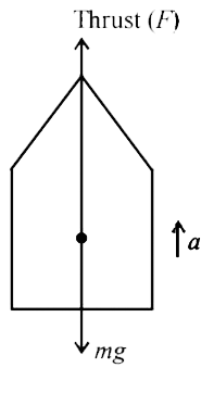
Answer
445.5k+ views
Hint
We know that thrust is defined as a mechanical force that is generated most often through the reaction between the accelerating masses of the gases that are taken into consideration. Based on this concept we have to solve this question.
Complete step by step answer
From the figure given, we can see that the force due to gravity mg acts on the rocket in the downward direction while the thrust F acts in the upward direction.

$F-m g=m a$.
By solving the above equation, we get,
$\therefore F=m(g+a)$.
Given,
Mass of rocket while lift-off (m) = $3.5 \times 10^{4}$kg
The initial acceleration of rocket while lift-off is $10 \mathrm{m} / \mathrm{s}^{2}$
Therefore, the thrust can be calculated with the equation given which evaluates to:
$=3.5+{{10}^{4}}(10+10)$
$=7\times {{10}^{5}}\text{N}$
Therefore, the correct answer is Option (B).
Note
We should know that thrust is mostly generated because of the reaction of the acceleration between the gases, but it should not be confused with acceleration. Trust is a vector quantity since it gives us an idea about the accelerating direction of the gas as well. The magnitude of the thrust depends on the amount of the gas that is accelerated and on the difference in the velocity of the gas that is passed through the engine.
We know that thrust is defined as a mechanical force that is generated most often through the reaction between the accelerating masses of the gases that are taken into consideration. Based on this concept we have to solve this question.
Complete step by step answer
From the figure given, we can see that the force due to gravity mg acts on the rocket in the downward direction while the thrust F acts in the upward direction.

$F-m g=m a$.
By solving the above equation, we get,
$\therefore F=m(g+a)$.
Given,
Mass of rocket while lift-off (m) = $3.5 \times 10^{4}$kg
The initial acceleration of rocket while lift-off is $10 \mathrm{m} / \mathrm{s}^{2}$
Therefore, the thrust can be calculated with the equation given which evaluates to:
$=3.5+{{10}^{4}}(10+10)$
$=7\times {{10}^{5}}\text{N}$
Therefore, the correct answer is Option (B).
Note
We should know that thrust is mostly generated because of the reaction of the acceleration between the gases, but it should not be confused with acceleration. Trust is a vector quantity since it gives us an idea about the accelerating direction of the gas as well. The magnitude of the thrust depends on the amount of the gas that is accelerated and on the difference in the velocity of the gas that is passed through the engine.
Recently Updated Pages
Who among the following was the religious guru of class 7 social science CBSE

what is the correct chronological order of the following class 10 social science CBSE

Which of the following was not the actual cause for class 10 social science CBSE

Which of the following statements is not correct A class 10 social science CBSE

Which of the following leaders was not present in the class 10 social science CBSE

Garampani Sanctuary is located at A Diphu Assam B Gangtok class 10 social science CBSE

Trending doubts
Which are the Top 10 Largest Countries of the World?

In what year Guru Nanak Dev ji was born A15 April 1469 class 11 social science CBSE

A rainbow has circular shape because A The earth is class 11 physics CBSE

How do you graph the function fx 4x class 9 maths CBSE

Fill the blanks with the suitable prepositions 1 The class 9 english CBSE

In Indian rupees 1 trillion is equal to how many c class 8 maths CBSE

The Equation xxx + 2 is Satisfied when x is Equal to Class 10 Maths

Why is there a time difference of about 5 hours between class 10 social science CBSE

Difference between Prokaryotic cell and Eukaryotic class 11 biology CBSE




